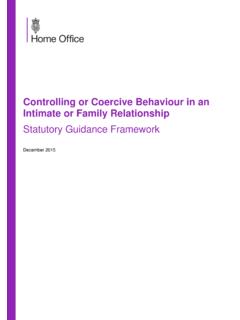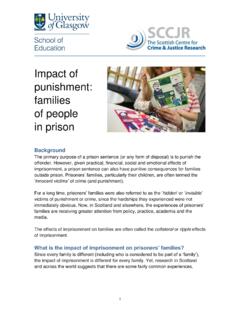Transcription of The Risk and Prevention of Maltreatment of Children with ...
1 Children s Bureau/ACYF/ | Email: | S INSIDEB ackground and researchAssessing for disabilitiesAssessing for maltreatmentPromising practices Additional resourcesBULLETIN FOR PROFESSIONALS January 2018 The Risk and Prevention of Maltreatment of Children With DisabilitiesChildren with disabilities are at least three times more likely to be abused or neglected than their peers without disabilities (Jones et al., 2012), and they are more likely to be seriously injured or harmed by Maltreatment (Sedlak et al., 2010). Even among Children with disabilities, the risk of Maltreatment varies by disability type (Jones et al., 2012; Lightfoot, 2014; Turner, Vanderminden, Finkelhor, Hamby, & Shattuck, 2011).This bulletin for professionals describes the scope of the problem, risk factors, and strategies for Prevention .
2 It examines the problem in terms of statistics and research; covers critical issues encountered when assessing a child with a disability for Maltreatment ; and provides information about promising Prevention , collaboration, and training approaches. The bulletin also includes a listing of helpful 2m017mhtcpc1sr:1 2 This material may be freely reproduced and distributed. However, when doing so, please credit Child Welfare Information Gateway. This publication is available online at Regarding Children With DisabilitiesEstimates vary regarding the number of Children with disabilities in the general population, depending on how disability is defined. According to the latest Census Bureau (2011) statistics, percent of school-aged Children (ages 5 17) have a disability.
3 According to federal child Maltreatment data, percent of child Maltreatment victims had a reported disability in 2014; that number increased to percent in 2015 ( Department of Health and Human Services [HHS], Administration for Children and Families, Children s Bureau, 2015). A recent study in Minnesota estimated that greater than one-third of Children reported for Maltreatment possess some type of disability (Hall-Lande, Hewitt, Mishra, Piescher, & LaLiberte, 2015). Of those Children in foster care in the United States, about one-third have a disability (Slayter, 2016).Statistics on the number of Children with disabilities in child welfare, however, are difficult to obtain for many reasons. Until the 2010 reauthorization of CAPTA, state child welfare agencies were not required to report disability information to the federal government.
4 This authorization mandates that states report (1) the number of Children under 3 years of age who are involved in a substantiated case of child Maltreatment and are eligible to be referred for early intervention services (see pp. 3 and 8 for more on early intervention services) and (2) the number of Children who were actually referred for those services. Although the reauthorization of CAPTA systematized data collection through the National Child Abuse and Neglect Data System (Child Welfare Information Gateway, 2013), it does not require information regarding types of disabilities or the number of Children with disabilities who are older than age 3 when they enter the child welfare system. In many ways, however, accurate statistics on the number of Children with disabilities are necessary for the development of public health services for this population (American Psychological Association, 2016).
5 DefinitionsChild Maltreatment is generally explained using the federal Child Abuse Prevention and Treatment Act (CAPTA) definition: Any recent act or failure to act on the part of a parent or caretaker, which results in death, serious physical or emotional harm, sexual abuse, or exploitation, or an act or failure to act which presents an imminent risk of serious harm ( 111 320).As it relates to Children , disability is defined as follows by the Individuals With Disabilities Education Act (IDEA): The term child with a disability means a child (1) with intellectual disabilities, hearing impairments (including deafness), speech or language impairments, visual impairments (including blindness), serious emotional disturbance (referred to in this chapter as emotional disturbance ), orthopedic impairments, autism, traumatic brain injury, other health impairments, or specific learning disabilities and (2) who, by reason thereof, needs special education and related services ( 111 256).
6 For IDEA definitions of types of disabilities, visit Background and ResearchThis section presents an overview of research and current trends regarding the Maltreatment of Children with disabilities. It describes relevant statistics as well as risk factors for Maltreatment , including how risk may vary by disability type. 2m017mhtcpc1sr:1 3 This material may be freely reproduced and distributed. However, when doing so, please credit Child Welfare Information Gateway. This publication is available online at Risk by Disability TypeNot all forms of disability carry the same level of risk, and not all Children diagnosed with the same type of disability experience Maltreatment equally. For example, Children with disabilities that affect conduct, such as attention deficit/hyperactivity disorder, may be vulnerable to physical abuse by parents or caregivers who may become frustrated by their behavior.
7 Children who rely on adults for their care, as well as Children who are nonverbal or hearing impaired, may be more likely than others to experience neglect or sexual abuse (Centers for Disease Control and Prevention , 2017). Knowing the characteristics of Children s disabilities can help child welfare professionals and service providers comprehend the barriers that these Children face; better recognize and respond to those challenges; and obtain a more informed perspective of each child s social, familial, and individual following links provide useful information for service providers about various types of disabilities, the characteristics associated with them, and services that may be available to Children with those disabilities.
8 These resources also may be helpful to parents of Children with disabilities. Categories of Disability Under IDEA, which was produced by the National Dissemination Center for Children With Disabilities, defines areas of developmental, or cognitive, delays for Children under age 3 to determine which Children may be eligible for state early intervention services. The Center for Parent Information and Resources website provides detailed descriptions of characteristics associated with each of the disabilities recognized by IDEA and potential services available to help Children and families of Children with disabilities. The Project IDEAL website provides basic definitions and general characteristics of a variety of disabilities and the impact of those disabilities on learning.
9 And Protective Factors While no single risk factor indicates that a child will necessarily be the victim of abuse or neglect, research reveals that Children with disabilities face an assortment of factors that place them at higher risk of Maltreatment than Children without disabilities. Children with disabilities and their families often encounter societal risk factors that may increase their risk for Maltreatment , such as isolation, discrimination, and lack of supports (Lightfoot, 2014). Additionally, they may be at heightened risk for Maltreatment due to risk factors related to characteristics of families, parents, Children , and specific disabilities. This section describes those risk factors and highlights Maltreatment in institutional and nonfamilial settings as well as protective factors.
10 Family or Parental Risk FactorsIt is important for professionals to understand the effects that raising a child with disabilities can have on family dynamics. Such knowledge can help child welfare professionals and/or service providers assess risk factors ( , stress), the family support system, challenges to effective family functioning, and the additional risks that poverty may present (Algood, Hong, Gourdine, & Williams, 2011). Stress and physical health: Providing additional care and supervision for Children with disabilities can increase the stress placed on families caring for Children with special needs (Fisher, Hodapp, & Dykens, 2008). Causes of stress can include additional financial costs, the physical and emotional health of parents or caregivers, and concerns about the future (Murphy, Christian, Caplin, & Young, 2007).














